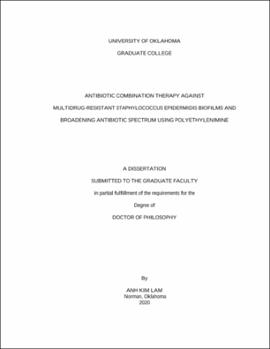| dc.description.abstract | Antibiotic resistance (AR) is a serious growing threat around the globe. There has been no new antibiotic class developed in the past 30 years, while antibiotic-resistant superbugs are emerging everywhere and becoming more and more life-threatening. In 2019, AR pathogens took away about 35,000 lives and infected over 2.8 million people a year in the United States alone. Experts predict that, by 2050, AR will be the top leading cause of death, claiming 10 million lives a year.
Motivated and dedicated to thousands of families who lose their loved ones each year to antibiotic-resistant infections, our research lab studies the defense mechanisms of superbugs. Instead of finding a new antibiotic, we study how to remove their resistance using a potentiator called BPEI (branched polyethylenimine). BPEI is a chemical compound that can disable the resistance factors of superbugs while traditional antibiotics (i.e. amoxicillin) can now actively target the vulnerable pathogens. It is called “combination therapy”. My initial specific contribution is study to fight one of the most commonly clinical isolates of Staph infections—multidrug-resistant Staphylococcus epidermidis. Previously known as a harmless commensal species on human skin, Staphylococcus epidermidis is now the first-ranking causative agent of hospital-related infections, with 24% mortality. It has become resistant to many antibiotics and thus acquired the name MRSE (Methicillin- Resistant Staphylococcus epidermidis). Additionally, MRSE bacteria can form dangerous biofilms – extra layers of self-made material – that protects them from antibiotics and helps them live on inanimate surfaces like medical devices for weeks to months. Persistent biofilms are also a leading cause of chronic wound infections. In the United States, a cost of $2 billion/year is estimated for S. epidermidis vascular-catheter-related bloodstream infections. This resistance is mainly governed by a protein called PBP2a, which the susceptible Staph bacteria do not have. The protein PBP2a has a very low affinity for traditional β-lactam antibiotics, thereby making first-choice antibiotics ineffective. Here, the use of BPEI becomes effective because exposure to BPEI molecules inhibits the function of PBP2a of MRSE, and therefore making them susceptible to existing antibiotics.
Many experiments and analyses were conducted by using multiple biochemical techniques including microtiter plate assays, growth and time-killing curves, bacterial colony forming units, visible and fluorescence spectroscopies, electron microscopies, Fourier-transform infrared spectroscopy, and mass spectrometry. Not only being effective against MRSE, BPEI can also broaden antibiotic spectrum against other bacterial species like MRSA, Pseudomonas aeruginosa, E. coli and their biofilms. Exact concentrations of each combination treatment were found for each bacterial strain. New mechanisms of action of BPEI against different bacteria and its effects on human inflammatory responses were also elucidated and reported in this dissertation. Better understanding of how superbugs react to each treatment helps us to design more and more powerful potentiators. The efficacy of BPEI in combination therapy has shown to be effective against more than 20 clinical isolates (patients’ swab from OUHSC) of drug-resistant pathogens. This enables BPEI to function as a broad-spectrum antibiotic potentiator which expands the opportunities to improve drug design (synthesis of BPEI analogs), antibiotic development, and therapeutic approaches (i.e. anti-inflammatory) against pathogenic germs. | en_US |
